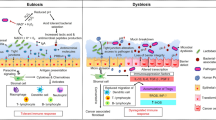Summary
This study investigated the expression and prognostic value of SHP-2 in cervical cancer caused by human papillomavirus (HPV) infection. Forty-five specimens from patients with cervical cancer (stage I–III), 32 specimens from patients with cervical intraepithelial neoplasia (CIN) (I, II) and 20 normal cervical samples from patients with hysteromyoma were collected in Department of Pathology for comparison. The expression levels of SHP-2 and IFN-β proteins were detected by using immunohistochemistry. The mRNA expression level of SHP-2 was detected by using quantitative real-time polymerase chain reaction (PCR). HPVs were detected by HPV GenoArray Test. The Spearman correlation was used to compare the expression level of SHP-2 in HPV infected cervical cancer vs non-HPV infected normal cervix. The level of SHP-2 protein expression in the cancer tissues (88.8%) was significantly higher than in CIN tissues (62.5%) and normal cervixes (45%) (P<0.05 and P<0.05, respectively). The SHP-2 mRNA levels in the cancer tissues were upregulated as compared with those in the normal cervixes (P<0.05). Twenty-one (46.7%) cervical cancers, 25 (78.1%) CINs and 17 (85%) normal cervixes showed IFN-β positive staining in cytoplasm. There was statistically significant difference in the expression rate of IFN-β between cervical cancer and normal cervix (χ 2=8.378, P<0.05) as well as between cervical cancer and CIN (χ 2=7.695, P<0.05). HPV16/18 infections could be found in normal cervixs (15%), CINs (68.7%) and cervical cancers (84.4%). There was a correlation between HPV infection and SHP-2 expression in cervical cancer (r s=0.653, P<0.05). SHP-2 may be a useful prognostic and diagnostic indicator for HPV infected cervical cancer. In cervical cancers, SHP-2 mRNA and protein overexpression was associated with IFN-β lower-expression.
Similar content being viewed by others
References
Matthews RJ, Bowne DB, Flores E, et al. Characterization of hematopoietic intracellular protein tyrosine phosphatases: description of a phosphatase containing an SH2 domain and another enriched in proline-, glutamic acid-, serine-, and threonine-rich sequences. Mol Cell Biol, 1992,12(5):2396–2405
Neel BG, Gu H, Pao L. The ’shp’ing news: SH2 domain-containing tyrosine phosphatases in cell signaling. Trends Biochem, 2003,28(6):284–293
Kharitonenkov A, Chen Z, Sures I, et al. A family of proteins that inhibit signaling through tyrosine kinase receptors. Nature, 1997,386(6621):181–186
Bennett AM, Tang TL, Sugimoto S, et al. Protein-tyrosine-phosphatase SHPTP2 couples platelet-derived growth factor receptor beta to Ras. Proc Natl Acad, 1994,91(15):7335–7339
Qu CK. The SHP-2 tyrosine phosphatase: Signaling mechanisms and biological functions. Cell Res, 2000, 10(4):279–288
You M, Flick LM, Yu D, et al. Modulation of the nuclear factor kappa B pathway by Shp-2 tyrosine phosphatase in mediating the induction of interleukin (IL)-6 by IL-1 or tumor necrosis factor. J Exp Med, 2001,193(1):101–110
Walboomers JM, Jacobs MV, Manos MM, et al. Human papillomavirus is a necessary cause of invasive cervical cancer worldwide. J Pathol, 1999,189(1):12–19
Bryan JT. Developing an HPV vaccine to prevent cervical cancer and genital warts. Vaccine, 2007,25(16):3001–3006
Lee KM, Chuang E, Griffin M, et al. Molecular basis of T cell inactivation by CTLA-4. Science, 1998,282(5397): 2263–2266
Yu WM, Hawley TS, Hawley RG, et al. Catalytic-dependent and independent roles of SHP-2 tyrosine phosphatase in interleukin-3 signaling. Oncogene, 2003,22(38):5995–6004
Huang Q, Lerner-Marmarosh N, Che W, et al. The novel role of the C-terminal region of SHP-2 involvement of Gab1 and SHP-2 phosphatase activity in Elk-1 activation. J Biol Chem, 2002,277(32):29 330–29 341
Ahmad S, Banville D, Zhao Z, et al. A widely expressed human protein-tyrosine phosphatase containing src homology 2 domains. Proc Natl Acad, 1993,90(6):2197–2201
Feng GS, Hui CC, Pawson T. SH2-containing phosphotyrosine phosphatase as a target of protein-tyrosine kinases. Science, 1993,259(5101):1607–1611
Vogel W, Lammers R, Huang J, et al. Activation of a phosphotyrosine phosphatase by tyrosine phosphorylation. Science, 1993,259(5101):1611–1614
Ke Y, Zhang EE, Hagihara K, et al. Deletion of Shp2 in the brain leads to defective proliferation and differentiation in neural stem cells and early postnatal lethality. Mol Cell Biol, 2007,27(19):6706–6717
Voena C, Conte C, Ambrogio C, et al. The tyrosine phosphatase Shp2 interacts with NPM-ALK and regulates anaplastic lymphoma cell growth and migration. Cancer Res, 2007,67(9):4278–4286
Xu R. Shp-2, a novel oncogenic tyrosine phosphatase and potential therapeutic target for human leukemia. Cell Res, 2007,17(4):295–297
Hao XP, Pretlow TG, Rao JS, et al. Beta-catenin expression is altered in human colonic aberrant crypt foci. Cancer Res, 2001,61(22):8085–8088
Jarboe JS, Johnson KR, Choi Y, et al. Expression of interleukin-13 receptor α2 in glioblastoma multiforme: implications for targeted therapies. Cancer Res, 2007,67(17): 7983–7986
An HZ, Zhao W, Hou J, et al. SHP-2 phosphatase negatively regulates the TRIF adaptor protein-dependent type I interferon and proinflammatory cytokine production. Immunity, 2006,25(6):919–928
Fitzgerald KA, McWhirter SM, Faia KL, et al. IKKepsilon and TBK1 are essential components of the IRF3 signaling pathway. Nat Immunol, 2003,4(5):491–496
Wang Y, Chen T, Han C. Lysosome-associated small Rab GTPase Rab7b negatively regulates TLR4 signaling in macrophages by promoting lysosomal degradation of TLR4. Blood, 2007,110(3):962–971
Takeda K, Kaisho T, Akira S. Toll-like receptors. Annu Rev Immunol, 2003,21(1):335–376
You M, Flick LM, Yu D, et al. Modulation of the nuclear factor kappa B pathway by Shp-2 tyrosine phosphatase in mediating the induction of interleukin (IL)-6 by IL-1 or tumor necrosis factor. J Exp Med, 2001,193(1):101–110
Du Z, Shen Y, Yang W, et al. Inhibition of IFN-a signaling by a PKC- and protein tyrosine phosphatase SHP-2-dependent pathway. Proc Natl Acad, 2005, 102(29):10 267–10 272
You M, Yu DH, Feng GS. Shp-2 tyrosine phosphatase functions as a negative regulator of the interferon-stimulated JAK/STAT pathway. Mol Cell Biol, 1999,19(3):2416–2424
Hong F, Nguyen VA, Gao B. Tumor necrosis factor α attenuates interferon α signaling in the liver: involvement of SOCS3 and SHP2 and implication in resistance to interferon therapy. FASEB J, 2001,15(9):1595–1597
Author information
Authors and Affiliations
Corresponding author
Additional information
This project was supported by a grant from the National Natural Science Foundation of China (No. 30973191).
Rights and permissions
About this article
Cite this article
Meng, F., Zhao, X. & Zhang, S. Expression and significance of SHP-2 in human papillomavirus infected cervical cancer. J. Huazhong Univ. Sci. Technol. [Med. Sci.] 32, 247–251 (2012). https://doi.org/10.1007/s11596-012-0044-4
Received:
Published:
Issue Date:
DOI: https://doi.org/10.1007/s11596-012-0044-4




